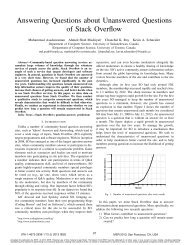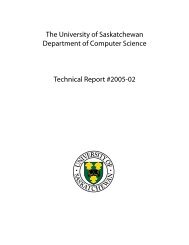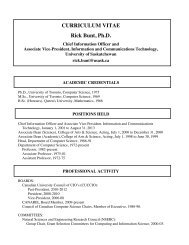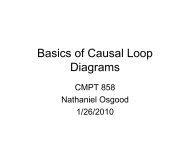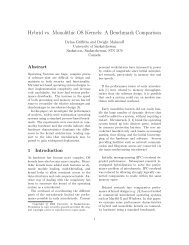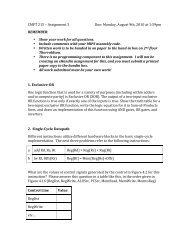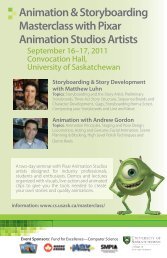Outline
Outline
Outline
Create successful ePaper yourself
Turn your PDF publications into a flip-book with our unique Google optimized e-Paper software.
CMPT 106 2/25/2010<br />
CMPT 106<br />
PLAYTESTING<br />
<strong>Outline</strong><br />
What is playtesting<br />
What playtesting is not<br />
Who to test<br />
A playtesting session<br />
2<br />
CMPT 106<br />
2/25/2010<br />
Lecture 1 1
CMPT 106 2/25/2010<br />
Playtesting<br />
Microsoft Games User<br />
Research<br />
over 3000 hours of<br />
playtesting<br />
more than 600 players<br />
3 CMPT 106<br />
2/25/2010<br />
A conversation about playtesting<br />
4<br />
CMPT 106<br />
2/25/2010<br />
Lecture 1 2
CMPT 106 2/25/2010<br />
A conversation about playtesting<br />
<br />
<br />
About your process... I was really<br />
impressed with the way that the<br />
narrative and the game design was<br />
well implemented. I'm wondering<br />
how you came to that.<br />
KS: A lot of it came out of the fact<br />
that we playtested our game every<br />
single week. We were watching<br />
people play the game and seeing<br />
how they reacted to certain<br />
situations, and tried to play up how<br />
they were feeling at the time with<br />
the dialogue and different turning<br />
points in the story. We definitely had<br />
our players and our customers in<br />
mind when we were making the<br />
game.<br />
5 CMPT 106 http://www.gamasutra.com/view/feature/3585/still_alive_kim_swift_and_erik_.php<br />
2/25/2010<br />
A conversation about playtesting<br />
<br />
<br />
What really impressed me specifically<br />
about the story was the way that the<br />
two were really one and the same, kind<br />
of. There was no exposition, really. The<br />
way that you found out about the<br />
world was by things that were there. I<br />
was wondering if that was designdriven<br />
or writer-driven, or was it a<br />
combination of the two<br />
EW: The combination of the two. It goes<br />
back to the playtesting again. The<br />
playtesting helps test the gameplay, but<br />
at the end of the playtest, we'd also ask<br />
people to tell us the story back. "Tell us<br />
everything that you remember about the<br />
story."<br />
If enough people weren't picking up on<br />
things, generally speaking, it was an<br />
indication to us that they just didn't care<br />
about it, which meant we should<br />
probably either cut it or in some cases<br />
where we didn't really want to let it go...<br />
KS: Make it better.<br />
6 CMPT 106<br />
2/25/2010<br />
Lecture 1 3
CMPT 106 2/25/2010<br />
A conversation about playtesting<br />
<br />
<br />
I've been telling people that I feel like<br />
Portal is one of the more sophisticated<br />
narrative-driven games, even though<br />
it's hard to call it that, really, because<br />
it's just actually well-realized.<br />
KS: It definitely has a lot to do with<br />
process and the fact that we sat down to<br />
watch people play our game. It's really<br />
incredible, how much information you can<br />
get just from watching someone play your<br />
game that hasn't played it before.<br />
Seeing what they think about the game<br />
and watching the expressions on their<br />
face, you can tell if they're happy with<br />
what they're feeling, or if they're bored<br />
or if they're sad. We were always very<br />
deliberately watching our players to see<br />
how we could make the experience better<br />
for them.<br />
7 CMPT 106<br />
2/25/2010<br />
Playtesting – What is it<br />
Playtesting is the single most important activity that<br />
a designer engages in<br />
BUT the one that designers understand the least<br />
Performed through the entire design process<br />
• Is the game functioning the way that you intended<br />
• Is the game internally complete<br />
• Is the game balanced and fun to play<br />
8<br />
CMPT 106<br />
2/25/2010<br />
Lecture 1 4
CMPT 106 2/25/2010<br />
What playtesting is not<br />
Just play it and gather feedback<br />
Playing is just part of the process<br />
When the designer and team talk about the feautres<br />
Internal design review<br />
Rigorously test each part of the software<br />
Quality assurance<br />
Marketing watches users through one-way glass<br />
Focus group testing<br />
Analyze how users interact with the interface<br />
Usability testing<br />
9<br />
CMPT 106<br />
2/25/2010<br />
Iterative Design<br />
You can‟t change game<br />
design right before<br />
shipping!<br />
Continuous process of<br />
playtesting, evaluating,<br />
and revising<br />
Testing cycle gets tighter<br />
close to ship dates<br />
Should we wait for beta<br />
Absolutely NOT<br />
Too late to make changes<br />
Stuck with a dud<br />
10 CMPT 106<br />
2/25/2010<br />
Lecture 1 5
CMPT 106 2/25/2010<br />
Who to test<br />
Self-testing<br />
When you are building a<br />
working version of your game<br />
Work with your team both as<br />
a group and as individuals<br />
Valuable in the foundation<br />
stage (experimenting with<br />
fundamental concepts)<br />
Goal: to make the game work<br />
by solving glaring problems<br />
As game development<br />
progresses, continue to test<br />
yourself, but rely more on<br />
outside testers<br />
<br />
11 CMPT 106<br />
2/25/2010<br />
Who to test<br />
Confidants<br />
People you know well like<br />
friends and family<br />
They bring fresh eyes and<br />
uncover different things<br />
Might need to explain things<br />
because the prototype may be<br />
incomplete<br />
Goal: get a version that can be<br />
played without much intervention<br />
Good for getting some<br />
feedback, but need to move<br />
away from friends as game<br />
matures<br />
• They are too harsh or too<br />
forgiving<br />
<br />
12 CMPT 106<br />
2/25/2010<br />
Lecture 1 6
CMPT 106 2/25/2010<br />
Who to test<br />
Strangers<br />
Hard to take criticism<br />
from people you have<br />
just met<br />
You will gain fresh<br />
perspective and insight<br />
Objective opinions<br />
untainted by<br />
knowledge of the<br />
game or personal ties<br />
13 CMPT 106<br />
2/25/2010<br />
Who to test<br />
Target audience<br />
Want testers who<br />
represent who will spend<br />
money on your game<br />
Get more relevant<br />
feedback<br />
Compare your game to<br />
others they have played<br />
(market research)<br />
Know what they like and<br />
dislike and will be able<br />
to articulate<br />
But don‟t be too narrow!<br />
14 CMPT 106<br />
2/25/2010<br />
Lecture 1 7
CMPT 106 2/25/2010<br />
Who to test<br />
15<br />
CMPT 106<br />
2/25/2010<br />
Who to test<br />
16<br />
CMPT 106<br />
2/25/2010<br />
Lecture 1 8
CMPT 106 2/25/2010<br />
Conducting a playtesting session<br />
<br />
<br />
<br />
Do not start by:<br />
Telling players about the game, how it works, plans for future development, your<br />
hopes and dreams<br />
Defeats the purpose of a fresh perspective!<br />
• You can never go back and get their natural first impression<br />
Also, you do not come in the box!<br />
Change your role:<br />
You are no longer designer, but investigator and objective observer<br />
Lead the player, record their actions, analyze their responses<br />
Don‟t interfere<br />
Give minimal explanation<br />
You must allow them to make mistakes!<br />
See how they approach the game<br />
If they get stuck, let them figure it out – you will learn from their mistakes<br />
If you can, have an objective person run the test while you observe<br />
Make a test script to keep you on track<br />
17<br />
CMPT 106<br />
2/25/2010<br />
The golden rule<br />
TREAT YOUR PLAYTESTERS WITH RESPECT<br />
18<br />
CMPT 106<br />
2/25/2010<br />
Lecture 1 9
CMPT 106 2/25/2010<br />
Playtest process<br />
1. Introduction (2-3 minutes)<br />
Yourself and the process<br />
You are not testing them, but are testing the game<br />
Audio and video, logging<br />
2. Warm-up discussion (5 minutes)<br />
<br />
<br />
Relax the player<br />
Find out about the tester<br />
• Tell me about some of the games you play<br />
• What do you like most about these games<br />
• What was the last game you purchased<br />
19<br />
CMPT 106<br />
2/25/2010<br />
Playtest process<br />
3. Play session (15-20 minutes)<br />
<br />
<br />
<br />
Remind them that difficulties they have will improve<br />
the game<br />
Observe their play from a distance<br />
Think-aloud<br />
• What choices are they making<br />
• What uncertainties they have when playing<br />
• Running monologue of the player‟s thoughts<br />
20<br />
CMPT 106<br />
2/25/2010<br />
Lecture 1 10
CMPT 106 2/25/2010<br />
Playtest process<br />
4. Discussion of game experience (15-20 minutes)<br />
Have one-on-one discussion with playtesters<br />
Develop a set of questions<br />
• Open-ended questions are more valuable at this stage<br />
• E.g., Overall what are your thoughts about the game<br />
• Were you able to learn how to play quickly<br />
• What is the objective of the game<br />
• Is there any information that would have been useful to you before<br />
starting<br />
• Is there anything that you don‟t like about the game<br />
• Was anything confusing Please take me through what you found<br />
confusing.<br />
• More specific questions later in the design process<br />
5. Wrap-up<br />
Thank them!<br />
21<br />
CMPT 106<br />
2/25/2010<br />
The golden rule<br />
TREAT YOUR PLAYTESTERS WITH RESPECT<br />
22<br />
CMPT 106<br />
2/25/2010<br />
Lecture 1 11
CMPT 106 2/25/2010<br />
Observation methods<br />
Three common approaches<br />
Simple observation<br />
Think-aloud<br />
Co-discovery learning<br />
23<br />
CMPT 106<br />
2/25/2010<br />
Simple Observation<br />
Player is give a task (or not), and evaluator just<br />
watches the user<br />
Problem: no insight into the player’s decision process or attitude<br />
24<br />
CMPT 106<br />
2/25/2010<br />
Lecture 1 12
CMPT 106 2/25/2010<br />
Think-aloud Protocol<br />
Players are asked to say<br />
what they are<br />
thinking/doing:<br />
What they believe is<br />
happening<br />
What they are trying to<br />
do<br />
Why they took an action<br />
Gives insight into what<br />
the player is thinking<br />
25 CMPT 106<br />
2/25/2010<br />
Think-aloud Protocol<br />
Problems:<br />
Awkward/uncomfortable for<br />
subject (thinking aloud is not<br />
normal!)<br />
“Thinking” about it may alter<br />
the way people perform their<br />
task<br />
Hard to talk when they are<br />
concentrating on problem<br />
Interferes with game play<br />
Still is the most widely used<br />
method in general industry<br />
26 CMPT 106<br />
2/25/2010<br />
Lecture 1 13
CMPT 106 2/25/2010<br />
Other Problems with Think-aloud<br />
27<br />
CMPT 106<br />
2/25/2010<br />
Retrospective Think-aloud<br />
Problems with Think-aloud:<br />
Awkward/uncomfortable for<br />
player (thinking aloud is not<br />
normal!)<br />
“Thinking” about it may alter<br />
the way people perform their<br />
task<br />
Hard to talk when they are<br />
concentrating on problem<br />
Interferes with game play<br />
Solution: Videotape the<br />
experience and perform a<br />
retrospective think-aloud<br />
Has its own problems<br />
Awkwardness of watching<br />
themselves on video<br />
Awkwardness of reliving<br />
mistakes<br />
Reflection of the experience<br />
rather than in context<br />
More about „what<br />
happened‟ than how they<br />
felt about it<br />
28 CMPT 106<br />
2/25/2010<br />
Lecture 1 14
CMPT 106 2/25/2010<br />
Co-discovery Learning<br />
Two people play<br />
together<br />
Normal conversation<br />
between the two<br />
players is monitored<br />
Removes awkwardness<br />
of think-aloud, more<br />
natural<br />
Provides insights into<br />
thinking process of<br />
both players<br />
29 CMPT 106<br />
2/25/2010<br />
Recording Observations<br />
Paper and pencil<br />
primitive but cheap<br />
evaluators record events, interpretations, and extraneous<br />
observations<br />
evaluator seems disengaged<br />
problem: writing is slow<br />
• prepared coding schemes can help; just tick off events<br />
Audio recording<br />
capture discussion (think aloud, co-discovery)<br />
hard to synchronize streams (e.g., interface actions)<br />
• (expensive) tools exist to help<br />
transcription is slow and difficult!<br />
• tools exist to help<br />
30<br />
CMPT 106<br />
2/25/2010<br />
Lecture 1 15
CMPT 106 2/25/2010<br />
Recording Observations<br />
Video recording<br />
can see what a user is doing<br />
(good to use one camera/scan converter for screen +<br />
one for subject)<br />
can be intrusive (at least initially)<br />
analysis can be challenging<br />
• annotation is so time consuming and very very boring<br />
Companies often build “usability labs” with one-way<br />
mirrors, video cams, etc.<br />
31<br />
CMPT 106<br />
2/25/2010<br />
A conversation about playtesting<br />
32<br />
CMPT 106<br />
2/25/2010<br />
Lecture 1 16
CMPT 106 2/25/2010<br />
Sidhe Griffths – Wii SpeedRacer<br />
http://www.gamasutra.com/view/feature/3894/practical_game_playtesting_a_.php<br />
<br />
<br />
“The first time players get their hands on<br />
the game always results in problems --<br />
and when it comes time to write up the<br />
report, I realize with each soul-destroying<br />
point that it's my job to then present this<br />
information to the developers.<br />
However, the light at the end of the tunnel<br />
is that we can find and tackle these<br />
problems while the game is still in our<br />
hands. Once it has been released, it is<br />
too late, which is far from a good thing.”<br />
One of the ways we were able to create<br />
such a solid game was through<br />
playtesting on those players who would<br />
be playing the game (in this case the<br />
target demographic was 9 - 14 year<br />
olds). Once they were in, every aspect of<br />
the session was recorded; from the<br />
gameplay to the player's expressions and<br />
the way they use the input device. While<br />
it may seem overkill, everything can<br />
potentially be used to fine-tune a game.<br />
33 CMPT 106<br />
2/25/2010<br />
Sidhe Griffths – Wii SpeedRacer<br />
http://www.gamasutra.com/view/feature/3894/practical_game_playtesting_a_.php<br />
<br />
Using the Wiimote for a driving game was<br />
something we thought would instantly be<br />
intuitive. While the game supported the Mario<br />
Kart wheel add-on, it could also be played<br />
without it. What we didn't foresee was the way<br />
people would take it upon themselves to use the<br />
device.<br />
The player was given a small animation<br />
showing how to hold the Wiimote, and we<br />
assumed that it was straightforward enough.<br />
However, what happened was that the majority<br />
of players perceived the animation as if it were<br />
from the top-down, and so would control the<br />
car as if they were using the steering wheel of<br />
a pickup truck.<br />
Therefore, for the loading screen we put in a<br />
simple black and white image of a television<br />
screen, with the Wiimote in front of it. It was<br />
hoped that this image would act like a frame of<br />
reference for holding the Wiimote. And it<br />
worked! The next time we ran a playtesting<br />
session the players picked up the Wiimote and<br />
were able to instantly drive.<br />
34 CMPT 106<br />
2/25/2010<br />
Lecture 1 17
CMPT 106 2/25/2010<br />
Sidhe Griffths – Wii SpeedRacer<br />
http://www.gamasutra.com/view/feature/3894/practical_game_playtesting_a_.php<br />
<br />
The solutions we found for the above issues<br />
were also adapted and used in one way or<br />
another for many of the others found within the<br />
game, and by spending time playtesting, which<br />
did not tax the development process, as<br />
sessions can be run concurrently with<br />
development itself, we removed a huge number<br />
of issues that would otherwise have potentially<br />
remained within the game after it had shipped.<br />
You need to ask what would have happened if<br />
that had been the case. It is certain that not<br />
only would the reviews have been a lot lower,<br />
but the word of mouth between the players<br />
themselves would have been extremely<br />
negative too.<br />
The final part of playtesting is to verify that the<br />
changes you have made actually work. This is a<br />
relatively easy matter and can be carried out<br />
when running other sessions. Observing if issues<br />
come up or not will quickly determine whether<br />
the problems have been solved.<br />
35 CMPT 106<br />
2/25/2010<br />
Write a playtesting script<br />
Helps you ignore your ego<br />
Learn to take criticism<br />
without emotion<br />
Do not answer criticisms,<br />
just write them down<br />
Your goal is not to get<br />
validation, but to make<br />
your game better<br />
Players want to please<br />
you and will respond<br />
according to your attitude<br />
Discourage snark<br />
36 CMPT 106<br />
2/25/2010<br />
Lecture 1 18
CMPT 106 2/25/2010<br />
Methods of playtesting<br />
Groups dynamics can be good for generating ideas<br />
and sometimes bad for evaluating ideas<br />
One-on-one testing: Sit down with individuals and<br />
observe<br />
Group testing: Get a group together to play your game<br />
Feedback forms: Give the testers a standard list of<br />
questions to answer (can feed into database)<br />
Interview: Sit down face-to-face with testers<br />
Open discussion: Conduct a one-on-one discussion or<br />
group discussion<br />
Data Hooks: Log events in the game itself<br />
37<br />
CMPT 106<br />
2/25/2010<br />
Styles of Questions: Open-ended<br />
Open-ended questions ask for opinions<br />
Good for general subjective information<br />
but, difficult to analyze rigorously<br />
E.g., “Can you suggest any improvements to the inventory<br />
interface”<br />
38<br />
CMPT 106<br />
2/25/2010<br />
Lecture 1 19
CMPT 106 2/25/2010<br />
Styles of Questions: Closed<br />
Restricts responses by supplying the choices for answers<br />
Can be easily analyzed …<br />
But, questions must be well designed!<br />
Did you access the journal:<br />
O never O 1-3 times O 4-5 times O more than 5 times<br />
How many hours a day do you spend playing computer games<br />
O over 4 hrs a day<br />
O between 2 and 4 hrs daily<br />
O between 1 and 2 hrs daily<br />
O less than 1 hr a day<br />
39<br />
CMPT 106<br />
2/25/2010<br />
Styles of Questions: Likert Scale<br />
Measure opinions, attitudes, and beliefs<br />
Asks user to judge a statement on a numeric scale<br />
Scale usually corresponds to agreement or<br />
disagreement with a statement<br />
The text on the computer screen was hard to read:<br />
strongly agree<br />
strongly disagree<br />
1 2 3 4 5<br />
40<br />
CMPT 106<br />
2/25/2010<br />
Lecture 1 20
CMPT 106 2/25/2010<br />
Styles of Questions: Semantic Anchors<br />
Opposing attitudes anchor the response<br />
The fighting minigame is:<br />
fun 1 2 3 4 5 boring<br />
easy 1 2 3 4 5 hard<br />
41<br />
CMPT 106<br />
2/25/2010<br />
Styles of Questions: Multi-Choice<br />
respondent offered a choice of explicit responses<br />
How do you most often get help with games (tick one)<br />
O on-line manual<br />
O paper manual<br />
O ask a friend<br />
Which types of games do you enjoy (tick all that apply)<br />
O action/adventure<br />
O RPG<br />
O sports<br />
O puzzle<br />
42<br />
CMPT 106<br />
2/25/2010<br />
Lecture 1 21
CMPT 106 2/25/2010<br />
Styles of Questions:<br />
Combining Open-ended & Closed Questions<br />
gets specific response, but allows room for user‟s opinion<br />
The boss battle was difficult:<br />
disagree agree comment<br />
1 2 3 4 5<br />
I couldn’t get the rocket launcher working!<br />
43<br />
CMPT 106<br />
2/25/2010<br />
The Play Matrix<br />
To help playtesters and<br />
players give context to their<br />
discussions<br />
Horizontal – Skill to chance<br />
Vertical – Metal to Physical<br />
Core aspects of game<br />
experiences<br />
Chess<br />
Blackjack<br />
Guitar Hero<br />
Tetris<br />
Whack-a-mole<br />
Halo<br />
Civilization<br />
44 CMPT 106<br />
2/25/2010<br />
Lecture 1 22
CMPT 106 2/25/2010<br />
The Play Matrix<br />
Good for stimulating<br />
discussion and analyzing<br />
gameplay<br />
Get your playtesters to<br />
think about the game and<br />
verbalize their feelings<br />
Pattern in the play matrix<br />
Use the play matrix to<br />
plot five of your favorite<br />
games<br />
What pattern do you see<br />
What does this tell you<br />
45 CMPT 106<br />
2/25/2010<br />
The Play Matrix<br />
<br />
Ask your testers to plot your<br />
game<br />
Is the outcome determined by skill<br />
or chance<br />
More by mental skill or physical<br />
dexterity<br />
Would they move the game one<br />
way<br />
• Note that different audiences will<br />
feel differently<br />
You can change aspects of your<br />
game (e.g., move a variable<br />
determined by chance to one<br />
determined by player choice<br />
• E.g., Remove dice and add cards<br />
that they can play<br />
46 CMPT 106<br />
2/25/2010<br />
Lecture 1 23
CMPT 106 2/25/2010<br />
Observations and Playtester comments<br />
Basic techniques (see Figure 9.10 in text)<br />
Do not lead<br />
• If players ask a question, give it back to them<br />
• If they reach an impasse, you have found a problem<br />
Remind them to think out loud if possible<br />
• Commentaries provide a window into players‟ expectations<br />
and choices<br />
Quantitative data<br />
• Don‟t just take notes, use forms to gather numbers<br />
47<br />
CMPT 106<br />
2/25/2010<br />
Test control situations<br />
Test specific aspects of the game<br />
The end of the game<br />
A random event that rarely takes place<br />
A special situation within the game<br />
A particular level of a game<br />
New features<br />
48<br />
CMPT 106<br />
2/25/2010<br />
Lecture 1 24
CMPT 106 2/25/2010<br />
Resources<br />
Valve's Faliszek: Playtesters Aren't Idiots, It's You<br />
http://gamasutra.com/php-bin/news_index.phpstory=19523<br />
Best Of GDC: The Secrets Of Portal's Huge Success<br />
http://gamasutra.com/php-bin/news_index.phpstory=17625<br />
GDMag Q&A: How Halo 3 Got Legendary<br />
http://www.gamasutra.com/phpbin/news_index.phpstory=17636<br />
Future Play 2007: Indie Dev Frozen North On Pushing The<br />
Prototype<br />
http://www.gamasutra.com/phpbin/news_index.phpstory=16269<br />
49<br />
CMPT 106<br />
2/25/2010<br />
Lecture 1 25



